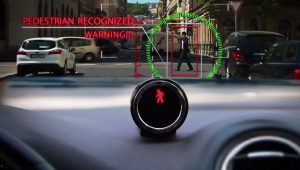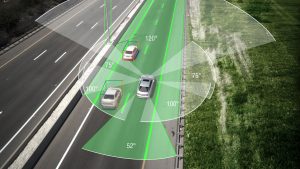Self-driving cars save lives and resources – Israeli company Mobileye has forged “the ultimate link between automobile and artificial intelligence”…

© Mobileye
Jerusalem, 13 Hartom Street. Here stands an inconspicuous office building of light brick with dark blue windows, one like many in the city. And yet this building is something special: It’s home to the renowned Israeli company Mobileye; it’s the place where tomorrow’s technology is being developed today – Mobileye is creating a brave new world of cars that drive without drivers.
In only a few years, the company has grown from start-up to global market-leader in the field of driving assistance systems. Almost all modern cars use technology from Mobileye, with the company itself claiming a market share of 90 percent. Giants like BMW, Volkswagen, Audi and Ford are among the Israeli company’s customers. In 2016, the company recorded sales of
US$ 358.2 million.
Mobileye is one of the few players on Israel’s colorful start-up scene to have made the leap to the international stage. The US chip maker Intel recently announced it would buy this small company bursting with great ideas for US$ 15.3 bn – the largest deal in Israeli history. That makes Mobileye worth ten times more than Opel was when General Motors sold the unit to Peugeot.
What is Mobileye’s secret? Who are the brains behind the company? “We’ve been in this business for 17 years. All this experience means we understand the problems, the hurdles, and the pitfalls developing the technology,” says Professor Amnon Shashua, the ingenious software engineer behind Mobileye. “And we know how to optimize the technology.”
56 years of age, with clean-shaven face and dense black hair, Shashua has little in common with the stereotype of the hip, baby-faced tech-company founder. He is a professor of computer sciences at the Hebrew University of Jerusalem and a leading expert in the field of artificial intelligence. Together with experienced businessman Ziv Aviram, he founded Mobileye in 1999 and quickly made the tech firm from Jerusalem an internationally successful multi-billion dollar player.
Years ago, companies like Google and Apple announced their ambitions to build self-driving cars. Today, much of the hype surrounding these plans has subsided. How can Mobileye fare any better? “Artificial intelligence is the future, and the car is the ideal platform for that,” says Shashua. “Mobileye is the ultimate link between car and artificial intelligence.” Mobileye understands as much about artificial intelligence as tech behemoths Google and Apple. But when it comes to cars, the start-up knows more than them. After all, Mobileye works for 27 carmakers around the globe.

© Mobileye
The company prizes safety above all else. As a result, Shashua and his team are not just interested in making sure the robot car’s artificial intelligence knows what the driver wants to do. The car must also recognize some wishes – such as reckless overtaking – come at the risk of accidents and cannot be fulfilled. And this system must work always perfectly – whether at night, in snow, fog or rain.
Three functions are vital for this. Mobileye uses sensors that interpret the field of view and filter out extraneous data – magic eyes that can locate other road users, pedestrians, for example, or cyclists and motorists. Then, there is the processing of the data to ensure the system’s maps are as up to date as possible. And lastly, there’s the ability quickly to transmit data and calculate a car’s handling.
There are some 35,000 road-traffic deaths each year in the US. Shashua is convinced widespread use of self-driving cars could reduce this total by two thirds. “Autonomous driving saves lives,” he says. “The problem is that society accepts that people kill other people in road-traffic accidents, but won’t accept people getting killed by robots. We need to learn to better deal with the existence of robotic cars. Because, put simply, the opportunities offered by the technology are limitless.”
Amnon Shashua can hardly contain himself when he talks about the possibilities of Mobileye’s technology: Cars that can recognize not only other vehicles, but also pedestrians and cyclists – and react intelligently to them; drivers relaxing in rush hour, in a traffic jam or in stop-go traffic – or reclining, reading a book, working, or making a phone call. When you arrive at the office, you simply send the car home so the family can continue to use it. What sounds like science fiction is in part already possible today. Many things that motorists encounter in everyday life come from Mobileye – tracking assistants, distance monitors, or adaptive headlights. Even older cars can be retrofitted with Mobileye technology without much effort. More and more fleet managers are using it to improve driver and vehicle safety, and to save costs by, for example, boosting car efficiency.
Even the fantasy of a fully automated car could soon become real. BMW and Intel are co-operating to put robot cars on the road by 2021. “We‘re just waiting for the technological revolution we can already see. We know the algorithms. We’re now only missing validation and testing,” says Shashua.
In an e-mail to their employees, Shashua and Aviram once wrote: “We always wanted to change the world.” Suddenly, they seem to be on the cusp of doing so – or they’re doing it already.
